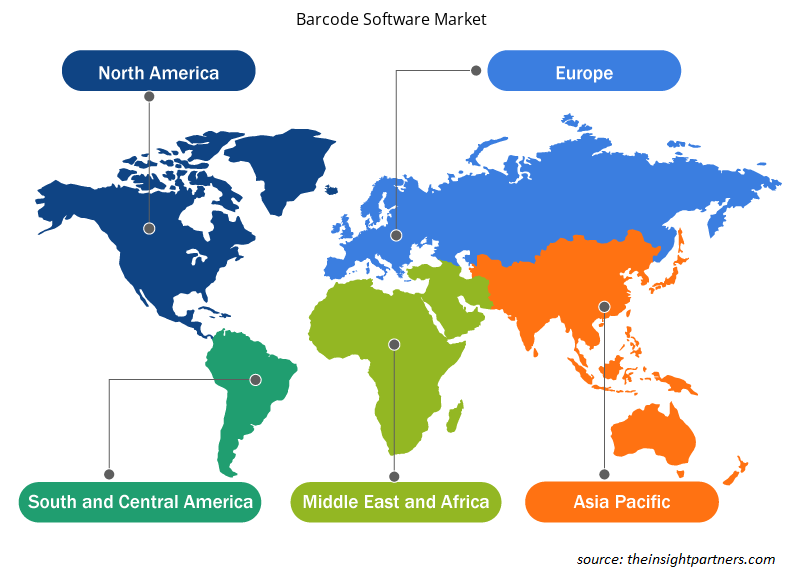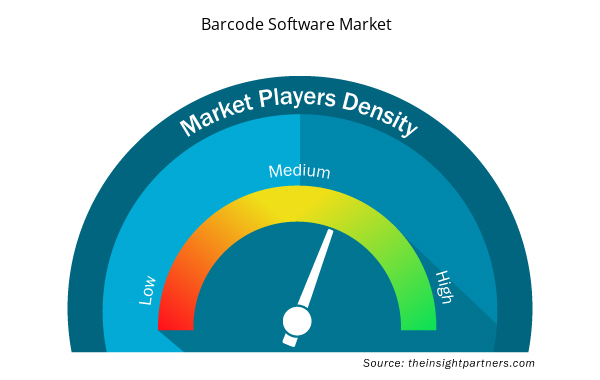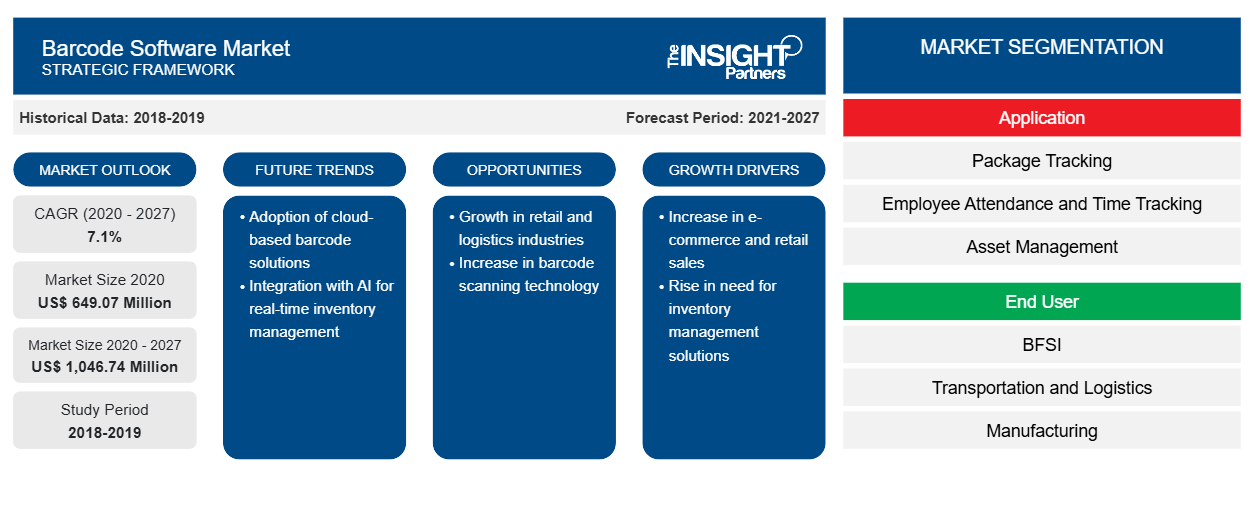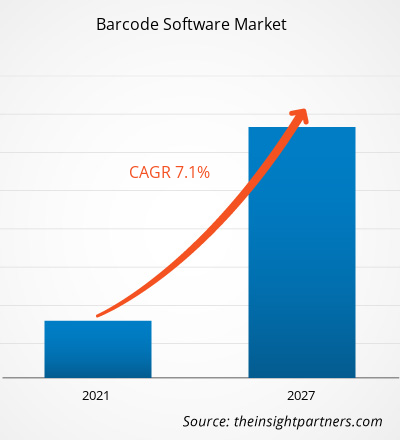Der Markt für Barcode-Software hatte im Jahr 2020 einen Wert von 649,07 Millionen US-Dollar und dürfte von 2020 bis 2027 mit einer durchschnittlichen jährlichen Wachstumsrate von 7,1 % wachsen.
Der Bedarf an Barcode-Software für das Supply Chain Management ist für das Wachstum des Marktes verantwortlich. Die Barcode-Technologie verbessert und erweitert jeden Aspekt des Supply Chain Managements. Sie macht den gesamten Geschäftsintegrationsprozess effektiv und reibungslos. Die Technologie hilft dabei, den Status von Produktlieferungen in kürzester Zeit zu verfolgen und reduziert so Fehler im Gesamtprozess. Darüber hinaus ist sie kostengünstig und einfach zu bedienen. Aufgrund dieser Vorteile wird die Verwendung von Barcode-Technologie bei Unternehmen immer beliebter, insbesondere im Supply Chain Management. Die Verfolgung über Barcode-Software hilft, Zeit und Geld zu sparen und stellt sicher, dass genaue Daten für die Entscheidungsfindung verwendet werden. Die manuelle Bestandsverwaltung dauert mehrere Stunden; andererseits ermöglicht die Barcode-Kennzeichnung die Verfolgung und Analyse von Lieferungen in Echtzeit, wodurch die gesamten Lieferkettenabläufe reibungslos und schnell ablaufen. Das Universitätsklinikum Dijon hat GS1-Barcodes implementiert, um eine höhere Sicherheit und Effizienz der Lieferkette zu gewährleisten. Darüber hinaus haben diese Barcodes dem Krankenhaus geholfen, reibungsloser und effizienter zu arbeiten und Fehler vollständig zu reduzieren. In einem ähnlichen Bericht zitierte die Zebra Technologies Corporation den Fall einer Bäckerei, die nach der Einführung eines Bestandsverfolgungssystems im ersten Jahr ihre Lager- und Vertriebskosten um 3 Millionen USD reduzierte. Durch die Überwachung und Erfassung weiterer Informationen zu ihren Produkten konnte die Bäckerei genaue und aktuelle Informationen zum Lagerbestand erhalten. Die Vorteile der Barcode-Technologie haben sie zu einer beliebten Methode gemacht, um Zeit zu sparen und Fehler zu reduzieren. Dies steigert die Nachfrage bei Unternehmen und eröffnet Lösungsanbietern die Möglichkeit, gezielt auf das Lieferkettensegment zu expandieren und Umsatz zu generieren.
Passen Sie diesen Bericht Ihren Anforderungen an
Sie erhalten kostenlos individuelle Anpassungen an jedem Bericht, einschließlich Teilen dieses Berichts oder einer Analyse auf Länderebene, eines Excel-Datenpakets sowie tolle Angebote und Rabatte für Start-ups und Universitäten.
- Holen Sie sich die wichtigsten Markttrends aus diesem Bericht.Dieses KOSTENLOSE Beispiel umfasst eine Datenanalyse von Markttrends bis hin zu Schätzungen und Prognosen.
Auswirkungen der COVID-19-Pandemie auf den Barcode-Softwaremarkt
Der Ausbruch des Coronavirus hat aufgrund von Lockdowns, Reiseverboten und Betriebsschließungen die Wirtschaft und Industrie in verschiedenen Ländern beeinträchtigt. Da die Mehrheit der Länder Lockdowns verhängt, sinkt die Nachfrage nach Barcode-Software deutlich. Dies liegt daran, dass die wichtigsten Länder, die Barcode-Software kaufen, ihre Investitionen in diese Komponenten eingeschränkt haben und einen beträchtlichen Prozentsatz ihres Budgets für die Bekämpfung von COVID-19 verwenden. Die vorübergehende Schließung von Produktionsstätten zeigt auch einen negativen Trend auf dem Markt für Barcode-Software. Die Fortsetzung der Ausbreitung von COVID-19 wäre für die Akteure auf dem Markt für Barcode-Software äußerst gefährlich .
Markteinblicke – Barcode-Softwaremarkt
Bedarf an präzisen Datenerfassungsprozessen in Echtzeit
Barcode-Softwarelösungen verbessern die Geschwindigkeit und Genauigkeit der Datenerfassung und ermöglichen es Unternehmen jeder Größe, ihre Geschäftsabläufe zu beschleunigen. Diese Softwareprodukte reduzieren menschliche Fehler und verbessern den Bestandsverwaltungsprozess. Mit zunehmendem Wettbewerb zwischen Unternehmen in den Bereichen Gesundheitswesen, Fertigung, Einzelhandel und Transport ist der Bedarf an genauen Technologien zur Echtzeiterfassung von Daten erheblich gestiegen, was die Nachfrage nach fortschrittlichen und einfach zu implementierenden Barcode-Softwarelösungen schafft. TEKLYNX bietet Lösungen für das Etikettendesign, mit denen einfache Etiketten mit Text, Bildern und Barcodes sowie komplexere Etiketten erstellt werden können, die verschiedenen Vorschriften entsprechen. Einige der Hauptfunktionen der Barcode-Software von TEKLYNX umfassen Design- und Integrationsmöglichkeiten, umfassende Datenbankverbindungen und branchenführende Etikettenvorlagen. Ebenso bieten Denso ADC, General Data Company, Honeywell International und Zebra Technologies Corporation effektive und effiziente Barcode-Softwarelösungen für verschiedene Branchenanforderungen und -bedürfnisse an. Hersteller verwenden Barcode-Software, um ihre Lagerbestände im Auge zu behalten und gleichzeitig Betriebsrisiken zu reduzieren und unnötige Verzögerungen im Geschäftsbetrieb zu vermeiden. Viele kleine, mittlere und große Fertigungsunternehmen sind auf der Suche nach effizienteren und kostengünstigeren Barcode-Softwarelösungen, was dem Gesamtmarkt Auftrieb verleiht.
Anwendungsbasierte Erkenntnisse
Basierend auf der Anwendung ist der Markt für Barcode-Software in Paketverfolgung, Mitarbeiteranwesenheits- und Zeiterfassung, Anlagenverwaltung und andere unterteilt. Das Segment Anlagenverwaltung hatte 2019 den größten Marktanteil.
Die Akteure auf dem Barcode-Softwaremarkt konzentrieren sich hauptsächlich auf die Entwicklung fortschrittlicher und effizienter Produkte.
- Im Jahr 2020 gab General Data die Übernahme der AmeriGraph Packaging Group (Atlanta, GA) bekannt. Mit dieser Übernahme erweitert General Data seine Kapazitäten im Bereich der Etikettenverarbeitung um erstklassige Etiketten und Schrumpffolienverpackungen für Konsumgüter und Lebensmittel und fügt außerdem ein Vertriebszentrum im Südosten hinzu, um bestehende Kunden besser bedienen zu können.
- Datalogic, ein weltweit führendes Unternehmen auf dem Markt für automatische Datenerfassung und Prozessautomatisierung, freut sich, im Jahr 2020 den Matrix™320 ankündigen zu können, den leistungsstärksten und kompaktesten industriellen Codeleser auf stationärer Bildbasis, der höchste Leistung, Flexibilität, Bedienersicherheit und niedrige Gesamtbetriebskosten bietet.
Regionale Einblicke in den Barcode-Softwaremarkt
Die regionalen Trends und Faktoren, die den Barcode-Softwaremarkt während des Prognosezeitraums beeinflussen, wurden von den Analysten von Insight Partners ausführlich erläutert. In diesem Abschnitt werden auch die Marktsegmente und die Geografie von Barcode-Software in Nordamerika, Europa, im asiatisch-pazifischen Raum, im Nahen Osten und Afrika sowie in Süd- und Mittelamerika erörtert.

- Erhalten Sie regionale Daten zum Barcode-Softwaremarkt
Umfang des Marktberichts zur Barcode-Software
| Berichtsattribut | Details |
|---|---|
| Marktgröße im Jahr 2020 | 649,07 Millionen US-Dollar |
| Marktgröße bis 2027 | 1.046,74 Millionen US-Dollar |
| Globale CAGR (2020 - 2027) | 7,1 % |
| Historische Daten | 2018-2019 |
| Prognosezeitraum | 2021-2027 |
| Abgedeckte Segmente | Nach Anwendung
|
| Abgedeckte Regionen und Länder | Nordamerika
|
| Marktführer und wichtige Unternehmensprofile |
|
Dichte der Marktteilnehmer für Barcode-Software: Deren Auswirkungen auf die Geschäftsdynamik
Der Markt für Barcode-Software wächst rasant, angetrieben durch die steigende Nachfrage der Endnutzer aufgrund von Faktoren wie sich entwickelnden Verbraucherpräferenzen, technologischen Fortschritten und einem größeren Bewusstsein für die Vorteile des Produkts. Mit steigender Nachfrage erweitern Unternehmen ihr Angebot, entwickeln Innovationen, um die Bedürfnisse der Verbraucher zu erfüllen, und nutzen neue Trends, was das Marktwachstum weiter ankurbelt.
Die Marktteilnehmerdichte bezieht sich auf die Verteilung der Firmen oder Unternehmen, die in einem bestimmten Markt oder einer bestimmten Branche tätig sind. Sie gibt an, wie viele Wettbewerber (Marktteilnehmer) in einem bestimmten Marktraum im Verhältnis zu seiner Größe oder seinem gesamten Marktwert präsent sind.
Die wichtigsten auf dem Barcode-Softwaremarkt tätigen Unternehmen sind:
- Bluebird Inc.
- Datalogic SPA
- Honeywell International, Inc.
- NCR Corporation
- Zebra Technologies Corporation
Haftungsausschluss : Die oben aufgeführten Unternehmen sind nicht in einer bestimmten Reihenfolge aufgeführt.

- Überblick über die wichtigsten Akteure auf dem Barcode-Softwaremarkt
Der Markt für Barcode-Software wurde wie folgt segmentiert:
Globaler Barcode-Softwaremarkt – nach Anwendung
- Paketverfolgung
- Mitarbeiteranwesenheit und Zeiterfassung
- Vermögensverwaltung
- Sonstiges
Globaler Barcode-Softwaremarkt – nach Endbenutzer
- BFSI
- Transport und Logistik
- Herstellung
- Gesundheitspflege
- Einzelhandel
- Sonstiges
Markt für Barcode-Software – nach Geografie
Nordamerika
- UNS
- Kanada
- Mexiko
Europa
- Frankreich
- Deutschland
- Italien
- Russland
- Vereinigtes Königreich
- Restliches Europa
Asien-Pazifik (APAC)
- Japan
- China
- Australien
- Indien
- Südkorea
- Restlicher Asien-Pazifik-Raum
Naher Osten und Afrika (MEA)
- Saudi-Arabien
- Vereinigte Arabische Emirate
- Südafrika
- Rest von MEA
Südamerika (SAM)
- Brasilien
- Argentinien
- Rest von SAM
Markt für Barcode-Software – Firmenprofile
- Bluebird Inc
- Dynamisches System Inc.
- CVISION TECHNOLOGIES, INC
- Datalogic SpA
- DENSO ADC
- General Data Company, Inc
- Honeywell International Inc
- NCR Corporation
- Zebra Technologies Corporation
- ZEBEX INDUSTRIES INC
- Historische Analyse (2 Jahre), Basisjahr, Prognose (7 Jahre) mit CAGR
- PEST- und SWOT-Analyse
- Marktgröße Wert/Volumen – Global, Regional, Land
- Branche und Wettbewerbsumfeld
- Excel-Datensatz



Report Coverage
Revenue forecast, Company Analysis, Industry landscape, Growth factors, and Trends

Segment Covered
This text is related
to segments covered.

Regional Scope
North America, Europe, Asia Pacific, Middle East & Africa, South & Central America

Country Scope
This text is related
to country scope.
Häufig gestellte Fragen
Based on application, the asset tracking segment is dominated the market in 2019. Enterprises across the industry vertical, use barcode technology to track and manage company asset in real-time. Data capture software offered by solution providers has transformed camera equipped devices into a powerful barcode scanner; thereby, helping organizations to effectively mobilize their asset management via various tracking apps.
Need for accurate real time data collection method along with increasing demand for such software among logistics & transportation and healthcare sector is driving the global barcode software market.
In terms of revenue share, Asia Pacific held the largest share of global Barcode Software market in 2019 and it is anticipated to continue its dominance over the forecast period of 2020 to 2027. North America is the second largest revenue contributor, followed by Europe in 2019. Strong industry base especially in BFSI, IT & telecom, automotive, healthcare, and retail sectors is the major factors responsible for high adoption of Barcode Software solutions in the Asia Pacific region.
Trends and growth analysis reports related to Technology, Media and Telecommunications : READ MORE..
The List of Companies - Barcode Software Market
- Bluebird Inc.
- Datalogic S.P.A.
- Honeywell International, Inc.
- NCR Corporation
- Zebra Technologies Corporation
- Dynamic Systems Inc.
- CVISION Technologies
- DENSO ADC
- General Data Company
- Zebex Industries Inc.
The Insight Partners performs research in 4 major stages: Data Collection & Secondary Research, Primary Research, Data Analysis and Data Triangulation & Final Review.
- Data Collection and Secondary Research:
As a market research and consulting firm operating from a decade, we have published and advised several client across the globe. First step for any study will start with an assessment of currently available data and insights from existing reports. Further, historical and current market information is collected from Investor Presentations, Annual Reports, SEC Filings, etc., and other information related to company’s performance and market positioning are gathered from Paid Databases (Factiva, Hoovers, and Reuters) and various other publications available in public domain.
Several associations trade associates, technical forums, institutes, societies and organization are accessed to gain technical as well as market related insights through their publications such as research papers, blogs and press releases related to the studies are referred to get cues about the market. Further, white papers, journals, magazines, and other news articles published in last 3 years are scrutinized and analyzed to understand the current market trends.
- Primary Research:
The primarily interview analysis comprise of data obtained from industry participants interview and answers to survey questions gathered by in-house primary team.
For primary research, interviews are conducted with industry experts/CEOs/Marketing Managers/VPs/Subject Matter Experts from both demand and supply side to get a 360-degree view of the market. The primary team conducts several interviews based on the complexity of the markets to understand the various market trends and dynamics which makes research more credible and precise.
A typical research interview fulfils the following functions:
- Provides first-hand information on the market size, market trends, growth trends, competitive landscape, and outlook
- Validates and strengthens in-house secondary research findings
- Develops the analysis team’s expertise and market understanding
Primary research involves email interactions and telephone interviews for each market, category, segment, and sub-segment across geographies. The participants who typically take part in such a process include, but are not limited to:
- Industry participants: VPs, business development managers, market intelligence managers and national sales managers
- Outside experts: Valuation experts, research analysts and key opinion leaders specializing in the electronics and semiconductor industry.
Below is the breakup of our primary respondents by company, designation, and region:

Once we receive the confirmation from primary research sources or primary respondents, we finalize the base year market estimation and forecast the data as per the macroeconomic and microeconomic factors assessed during data collection.
- Data Analysis:
Once data is validated through both secondary as well as primary respondents, we finalize the market estimations by hypothesis formulation and factor analysis at regional and country level.
- Macro-Economic Factor Analysis:
We analyse macroeconomic indicators such the gross domestic product (GDP), increase in the demand for goods and services across industries, technological advancement, regional economic growth, governmental policies, the influence of COVID-19, PEST analysis, and other aspects. This analysis aids in setting benchmarks for various nations/regions and approximating market splits. Additionally, the general trend of the aforementioned components aid in determining the market's development possibilities.
- Country Level Data:
Various factors that are especially aligned to the country are taken into account to determine the market size for a certain area and country, including the presence of vendors, such as headquarters and offices, the country's GDP, demand patterns, and industry growth. To comprehend the market dynamics for the nation, a number of growth variables, inhibitors, application areas, and current market trends are researched. The aforementioned elements aid in determining the country's overall market's growth potential.
- Company Profile:
The “Table of Contents” is formulated by listing and analyzing more than 25 - 30 companies operating in the market ecosystem across geographies. However, we profile only 10 companies as a standard practice in our syndicate reports. These 10 companies comprise leading, emerging, and regional players. Nonetheless, our analysis is not restricted to the 10 listed companies, we also analyze other companies present in the market to develop a holistic view and understand the prevailing trends. The “Company Profiles” section in the report covers key facts, business description, products & services, financial information, SWOT analysis, and key developments. The financial information presented is extracted from the annual reports and official documents of the publicly listed companies. Upon collecting the information for the sections of respective companies, we verify them via various primary sources and then compile the data in respective company profiles. The company level information helps us in deriving the base number as well as in forecasting the market size.
- Developing Base Number:
Aggregation of sales statistics (2020-2022) and macro-economic factor, and other secondary and primary research insights are utilized to arrive at base number and related market shares for 2022. The data gaps are identified in this step and relevant market data is analyzed, collected from paid primary interviews or databases. On finalizing the base year market size, forecasts are developed on the basis of macro-economic, industry and market growth factors and company level analysis.
- Data Triangulation and Final Review:
The market findings and base year market size calculations are validated from supply as well as demand side. Demand side validations are based on macro-economic factor analysis and benchmarks for respective regions and countries. In case of supply side validations, revenues of major companies are estimated (in case not available) based on industry benchmark, approximate number of employees, product portfolio, and primary interviews revenues are gathered. Further revenue from target product/service segment is assessed to avoid overshooting of market statistics. In case of heavy deviations between supply and demand side values, all thes steps are repeated to achieve synchronization.
We follow an iterative model, wherein we share our research findings with Subject Matter Experts (SME’s) and Key Opinion Leaders (KOLs) until consensus view of the market is not formulated – this model negates any drastic deviation in the opinions of experts. Only validated and universally acceptable research findings are quoted in our reports.
We have important check points that we use to validate our research findings – which we call – data triangulation, where we validate the information, we generate from secondary sources with primary interviews and then we re-validate with our internal data bases and Subject matter experts. This comprehensive model enables us to deliver high quality, reliable data in shortest possible time.


 Holen Sie sich ein kostenloses Muster für diesen Bericht
Holen Sie sich ein kostenloses Muster für diesen Bericht